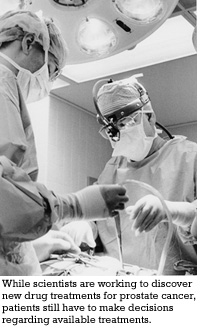Early Treatment Options for Prostate Cancer
 Different treatment options allow for more success in early treatment of localized prostate cancer.
Different treatment options allow for more success in early treatment of localized prostate cancer.
“Watchful Waiting”
The most conservative, least invasive treatment for prostate cancer is so-called “watchful waiting,” which also includes dietary therapy. Watchful waiting is only safe for older men who have both a low-grade and a low-volume prostate cancer.
If the patient is younger or has a higher-grade tumor or a higher stage tumor, watchful waiting can be dangerous. Even in appropriate candidates for “watchful waiting”, 50% of the tumors will progress to require treatment within five years.
Also, even with the earliest diagnosis, the prostate cancer is not always contained within the prostate. The cancer can progress to an incurable stage while the patient is “watchfully waiting.”
Radical Prostatectomy
The gold standard of treating prostate cancer is removal of the prostate, a radical prostatectomy.
The concept is simple. If the cancer is contained within the prostate gland, and the prostate is removed, the cancer is cured.
In more recent patients, in what we call the PSA screening era, 70% to 80% of prostate cancers are found to be contained within the prostate.
Radical prostatectomy is the only treatment that actually removes the cancer. All other treatments leave cancer in the body and depend on an outside agent to destroy it.
Even with radical prostatectomy, sometimes when we think that the cancer has been completely removed, it has spread outside the prostate. One of the advantages of radical prostatectomy is if the tumor has just barely spread outside the prostate, many patients can still be successfully treated with postoperative radiotherapy.
The problems with radical prostatectomy are that it is a major operation and most men fear the possible complications of urinary incontinence and of impotency.
Regarding a patient’s fear of urinary incontinence, I consider a patient incontinent if he has to wear any protection at all. Using that definition, about 8% of my patients have some incontinence. However, most of these patients have what I call “normal female continence,” i.e., they are continent under normal circumstances, but if they cough or sneeze or laugh, or sometimes move suddenly, they might leak a drop or two of urine. So, they wear a protective pad as a precaution. About 1 to 2% have severe incontinence that requires an operation to insert an artificial urinary sphincter. Return of continence is better in younger patients.
The most difficult part of radical prostatectomy is preserving potency. The result depends on the patient’s age and how good the erections were before surgery. Eighty-five to 90% of men in their forties will recover erections, but fewer than 50% of men in their seventies recover erections.
If erections are completely normal before surgery, there’s good recovery in 80% of patients, but if they have marginal erections to start with, then the expectations are less.
Other complications of surgery can occur such as blood clots in the leg or pelvic veins, heart attack, wound infection, or situations possible with any major operation, but the mortality rate is very low.
In my patients, the mortality rate from complications is zero. In the American College of Surgeons survey, the mortality rate is 0.4%.
Postoperative Radiotherapy
In patients who have tumor recurrence after radical prostatectomy, postoperative radiotherapy is often effective.
If the PSA rises after radical prostatectomy and radiotherapy is given to the area where the prostate was, there is a 70% chance the PSA will again become undetectable.
In those patients whose PSA does become undetectable, there is a 70% chance that it will remain undetectable. So, 70% of 70% is roughly a 50% chance that patients who have a recurrence could still be cured by radiotherapy.
This percentage may improve more in the future with 3-dimensional conformal therapy that allows higher doses of radiation to be given with less risk of damage to the surrounding tissues.
The important thing about postoperative radiotherapy is to begin treatment before the PSA is higher than 1. The sooner the treatment, the more likely it is to be successful.
In some patients treated with radical prostatectomy the pathologist finds cancer at the margin of resection or a microscopic extension of cancer outside the prostate. For these patients, the dilemma is should their PSA levels just be monitored to see if they rise, or should they automatically receive postoperative radiotherapy as a preventive measure.
From the cancer-control standpoint, it is better to have radiotherapy as a preventive measure.
One study showed that in patients with unfavorable findings in their pathology report who received radiotherapy three to four months after surgery as a preventive measure, 90% of the patients had no recurrence 5 years afterwards. However, 60% also did fine without the radiotherapy.
Many patients fear the side effects of radiation and feel they don’t want to take these risks unless they are sure they need radiotherapy. They decide to take a chance and avoid postoperative radiation unless their PSA begins to rise.
Usually, I recommend postoperative radiotherapy for patients with positive margins.
Laparoscopic Radical Prostatectomy
Laparoscopic radical prostatectomy, developed largely in France, is now performed at a few institutions in this country. My current assessment is that there is no material advantage in this treatment for the patient as there is for laparoscopic removal of a gallbladder or even a kidney. I believe that the ability to preserve potency and obtain clear surgical margins is less certain with laparoscopic radical prostatectomy than with the standard open radical prostatectomy.

Primary Padiotherapy
Another treatment option for early prostate cancer is primary radiotherapy. Radiotherapy can kill cancer cells and cure some patients. Radiotherapy is attractive to many patients because it is less invasive than an operation.
The major drawback of radiotherapy is that about 30% to 40% of prostate cancers contain at least a few cells that are resistant to radiotherapy. The radiation might destroy 99.9% of the cells, but if there are a few cells left behind, then the radiation will not eradicate the cancer.
The other drawback of radiotherapy, particularly the seed implantation, is that if the seeds are not implanted with perfect geometry some areas don’t receive sufficient doses of radiation such that, even if the tumor cells are sensitive to radiation, they may not get enough radiation to destroy the cancer.
The side effects of radiotherapy are related to radiation-induced injury to the rectum and bladder, which can cause diarrhea, rectal bleeding, urinary frequency and bleeding from the bladder. Rarely, radiotherapy causes incontinence, and in some cases, particularly with seed therapy, long-term urinary retention. Approximately 50% of patients lose their erections within one year following radiotherapy.
A disadvantage of radiotherapy is that there is no good curative salvage therapy if there is tumor recurrence. It is more risky to remove the prostate after the tissues have been damaged by radiation. It can be done, but the complication rate is ten-fold higher.
IMRT (Intensity Modulated Radiotherapy)
The latest development in the area of radiotherapy is intensity modulated radiotherapy, called IMRT.
With conventional radiotherapy, the radiation beam passes through the patient from front to back and from side to side, producing a box-shaped radiation field in the patient’s pelvis that includes not only the prostate but also a substantial volume of normal surrounding tissue.
With 3-dimensional conformal therapy, and particularly intensity modulated radiotherapy, the computer can generate a curved radiation field that focuses on the tumor and reduces the radiation dose to surrounding tissues, thus reducing the side effects.
Brachytherapy
Radioactive seed implantation, called brachytherapy, is becoming a popular treatment for prostate cancer.
Some of the published results with seeds are as good or better than the best published results reported for radical prostatectomy; however, some problems occur with the interpretation of these results as related to how treatment success and failure are defined after brachytherapy.
With radical prostatectomy, if the prostate has been removed, the postoperative PSA should be should be undetectable. If the PSA is not undetectable, then you know that the surgery has not done the job.
With radiotherapy, the PSA level slowly drifts down, sometimes “bouncing” up again due to radiation-induced prostatitis, and it’s more difficult to determine whether all cancer cells have been destroyed.
Results reported for radiotherapy, and particularly seed therapy, may be as good as results of radical prostatectomy, but one has to wonder whether the criteria they are using for calling favorable results are as rigorous as they should be.
In one study of seed implantation from Atlanta and Seattle, 88% had no recurrence 5 years later, and 83% were free of recurrence at 10 years. However, if the criteria of an undetectable PSA is used, only 57% would be considered cured in the Atlanta group, and 55% would be considered cured in the Seattle group. Using strict criteria for cure, the results don’t look so good.
The truth is that it is not yet known whether seed implantation will prove to be as effective as radical prostatectomy. My personal view is that the seed implantation will not be as effective.
Freezing the Prostate
Cryoablation, or freezing the prostate, is another less invasive treatment for prostate cancer. It involves inserting probes in the prostate gland through which liquid nitrogen is circulated.
Cryoablation was tried and then fell out of favor, mainly because the doctors weren’t being reimbursed for doing it. Recently, the procedure is reimbursed, and so it is coming back to some extent.
This procedure creates an ice ball as the prostate gland is frozen. Ideally, it would freeze the whole prostate and kill every cancer cell.
The real problem in performing cryoablation is that the backside of the prostate is situated adjacent to the rectum, and prostate cancer usually arises in the backside of the prostate very near to the edge of the gland. In order to kill all prostate cancer cells, it is necessary to freeze the gland all the way out to its capsule.
Attempting to freeze out to the capsule risks freezing the rectal wall and producing a fistula between the rectum and the prostate, a horrible complication.
To avoid this possibility, doctors don’t allow the freezing to extend to the edge of the prostate. As a result, there often is a “rind” of viable tissue left in the peripheral part of the prostate that is under-treated, and the cancer can come back.
Recently, the technology has been improved, but the statistics after cryoablation treatment for PSA-free recurrence rates and the long-term biopsy studies showing whether cancer is present are not very good.
Also, if cryoablation fails, it is very difficult to remove the prostate; therefore, salvage therapy following cryoablation is limited. Most patients become impotent following cryoablation.
Hormonal Therapy
Hormonal therapy is sometimes used in treating local disease.
Although hormonal therapy can control prostate cancer for long periods of time (I have one patient who has been in complete remission for 19 years on hormonal therapy), it is never curative, and eventually the prostate cancer will come back.
Other downsides of hormonal therapy are side effects: impotency, hot flashes, muscle loss, osteoporosis, loss of energy, and weight gain. Because of these side effects, many men opt for intermittent hormonal therapy so that they get a vacation from the side effects.
It’s not really known whether intermittent hormonal therapy is as effective as continuous hormonal therapy. The comparisons are currently under study. Also, whether hormonal therapy should be given early in the course of disease or whether it can be postponed is a matter of debate.
In a recent study, men who had been treated with radical prostatectomy, radiotherapy, or watchful waiting were randomized to receive high-dose Casodex hormonal therapy or placebo.
As expected, Casodex therapy delayed tumor recurrence. Accordingly, some doctors are recommending Casodex therapy as an auxiliary treatment; however, Casodex is expensive, and many men either do not need it or could safely wait until treatment is necessary.











